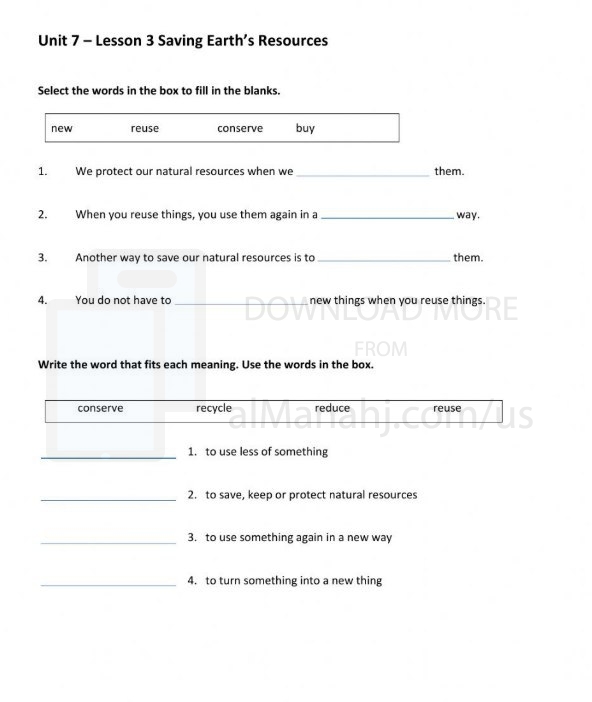| You are here: Almanahj Website ⇒ American curriculum ⇒ 3rd Grade ⇒ Geology ⇒ Term 1 | ||
|---|---|---|
Worksheet about Using earths resources | ||
|---|---|---|
| Subject: Geology | ||
| 3rd Grade | ||
| Term 1 | ||
| Year: 2023/2024 | ||
| Size: 278.9KB | ||
| Number of clicks: 200 | ||
| Publish date:December 05, 2023 | ||
| Added by: Eman | ||
| Last download date: 2024-09-13 07:46:53 | By: theodor Jasmine | |
| File info: Earth's resources refer to the various materials and substances that are naturally occurring on our planet and play a vital role in supporting life and human civilization. Here are some of the key Earth's resources: 1. Water: Water is a fundamental resource for all forms of life. It is essential for drinking, agriculture, industry, and ecosystem functioning. The Earth's water resources include freshwater lakes, rivers, groundwater, and the oceans. 2. Air: The Earth's atmosphere is composed of gases, primarily nitrogen (78%) and oxygen (21%), along with trace amounts of other gases. Air is crucial for respiration and supports the planet's climate and weather systems. 3. Fossil Fuels: Fossil fuels, such as coal, oil, and natural gas, are formed from the remains of ancient plants and animals. They are non-renewable energy sources and have been the primary fuel for powering industrial processes, transportation, and electricity generation. 4. Minerals: Earth's crust contains a wide variety of minerals, including metals (such as iron, copper, and gold), precious stones (like diamonds and emeralds), and industrial minerals (such as gypsum and limestone). These minerals are used in construction, manufacturing, and various industries. 5. Forests: Forests are important resources that provide timber, wood products, and habitats for a diverse range of plant and animal species. They also play a crucial role in carbon sequestration, climate regulation, and maintaining biodiversity. 6. Agricultural Land: Arable land and fertile soils are vital resources for agriculture, allowing the production of food crops and supporting livestock farming. Sustainable land management practices are necessary to ensure long-term food security. 7. Renewable Energy Sources: Earth's renewable resources include solar energy, wind energy, hydroelectric power, geothermal energy, and biomass. These sources are replenished naturally and offer alternatives to fossil fuels, reducing greenhouse gas emissions and environmental impact. 8. Biodiversity: Earth's diverse ecosystems and the species within them are invaluable resources. Biodiversity provides ecological services, such as pollination, nutrient cycling, and pest control, and contributes to scientific knowledge, medicine, and cultural heritage. 9. Freshwater Resources: Apart from water bodies, freshwater resources include underground aquifers, wetlands, and glaciers. These resources are crucial for drinking water, irrigation, and sustaining aquatic ecosystems. 10. Earth's Atmosphere: Earth's protective atmosphere shields us from harmful solar radiation and provides the conditions necessary for life. It also plays a crucial role in regulating the planet's temperature and climate. It is important to manage and conserve these resources sustainably to ensure their availability for future generations and to minimize detrimental impacts on the environment. | ||
| Downloading link Worksheet about Using earths resources |
|---|
|
1701758771.pdf
The file is being prepared for download
|
| File images |
|---|
 |